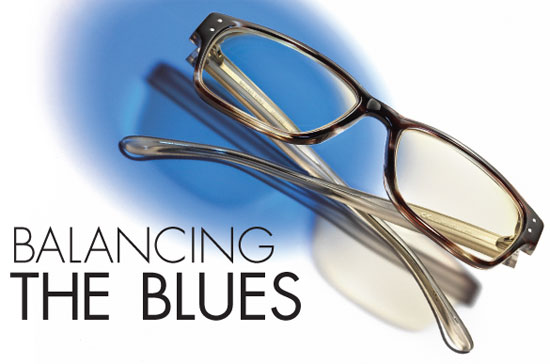
Photograph by Ned Matura; Frame: Michael Kors 284M from Marchon Eyewear; Lenses: Blutech lenses from VSP Optics Group
By Cheryl G. Murphy, OD
On a sunny day our life is lit up with blue. The bright blue sky is spread out like a cheerful canopy above us. We need some of the natural blue light it bestows upon us since it serves as a biological reminder to our bodies that it is daytime. It also makes us feel alert, happy, energized and awake, and adds to our color perception. However, exposure to artificial blue light at the wrong time of day can negatively impact our sleep cycle, and recent studies have shown that a particular type of blue light found in natural and artificial light known as High Energy Visible or blue-violet light can wreak havoc on our eye health.
Man’s love affair with light has only burned brighter since our cave dwelling days. Over 120 years ago, the invention of electricity and the integration of the lightbulb into our homes revolutionized our daily lives. No longer did we have to hold our caveman torches, burn our candles or hunt down Moby Dick to fill our oil lamps. We could harness the power of light at the flick of a switch thanks to the commercialization of Edison’s incandescent lightbulb. Today, as the evolution of artificial light continues and progresses toward LED and fluorescent light sources, we now find ourselves bathed in blue light. Smartphones, TVs, computers, tablets and new energy-efficient lightbulbs known as compact fluorescent lamps or CFLs all emit a high concentration of blue wavelength light. Incandescent bulbs and other predecessors to the newer LED and fluorescent lights emitted a high concentration of yellow wavelength light. Having a higher amount of emitted blue wavelength light is one of the reasons why these newer screens seem whiter, brighter, more crisp and fresh.
Blue light itself is nothing new, it is as old as the sky above us. It has been present in natural light and in artificial light in varying concentrations. Blue light is visible light which radiates at a short wavelength placing it at one end of the visible light spectrum with a range of approximately 380-500 nanometers. Blue-violet light (380-455 nm) is very close in wavelength to ultraviolet light (10-380 nm), a well-known hazard to our eyes and our health if we are exposed to it in repeated, large doses. Now recent studies have revealed that blue-violet light can cause retinal cell death, contribute to cataract formation and accelerate retinal damage in those who have macular degeneration.
The process by which blue-violet light causes retinal damage is still being studied, but it is said that blue-violet light disrupts cellular metabolism in the retinal pigment epithelium layer. This layer contains melanin granules which attract and absorb the energy found in shorter wavelengths of light like blue light. After absorbing this energy, photochemical lesions are formed which impair metabolic cell function in the RPE layer leading to retinal cell death there. People with macular degeneration and those at risk for it should take precautions to protect themselves against the damaging effects that blue light may have on the retina.
Interestingly, those with nuclear sclerotic cataracts (or who have some natural yellowing of their crystalline lens) may have a bit of serendipitous protection against blue light damaging their retinas. Their yellowed crystalline lenses will in some cases naturally filter out some of the blue light to which they are exposed and obstruct its entrance deeper into the eyes thereby stopping it before it has a chance to reach their retinas. Children under the age of 18 and also patients who have had cataract surgery and who now have artificial lens implants are said to be at a higher risk for retinal damage from blue light since their young crystalline lenses or their artificial lens implants are crystal clear and therefore do not impede the passage of blue light. Ironically, even though the natural aging and yellowing of the crystalline lens may provide some protection for the retina against blue light, further exposure of the yellowed crystalline lens itself to blue light will accelerate its cataract progression. Advanced cataracts cause decreased best corrected visual acuity, increased glare and decreased contrast sensitivity. So eyes of every age and stage are susceptible to the perils of blue light.
Luckily, the optical industry has evolved its line of protection for all eyes. Innovative new treatments and lenses have been invented to shield eyes from the flood of blue-violet light, which we now endure each day. These products selectively filter out blue-violet light and thereby protect the eyes from cataract progression and potential retinal damage while still allowing some blue light to pass, particularly blue-turquoise light with wavelengths of approximately 460-500 nanometers. This minimizes the harmful effects that blue light can have on our eye health, while still allowing the body and the eyes to receive the positive benefits of blue light like proper color perception, amplified attention levels, wakefulness and the modulation of melatonin production.
One of the benefits of blue light is that it helps to regulate our sleeping pattern because its presence suppresses melatonin production. Melatonin is a hormone that makes our bodies drowsy and ready for sleep. In the absence of blue light, specialized cells in our retina called intrinsically photosensitive retinal ganglion cells (ipRGCs) become switched on. When they are activated, they send a signal to the brain telling the pineal gland to start the process of melatonin production. When melatonin is produced in our bodies, it lets us know it’s time for rest. If it is produced at a particular time on a regular basis, our sleep cycle and circadian rhythm become set to that time. We wouldn’t want all blue light to be blocked completely because then we would not receive any stiulation from blue light, like that of the bright blue sky, telling our bodies when it is daytime and when it is nighttime.
However, natural blue light is not the only light that sets off our ipRGCs. Artificial blue light in our everyday lives can also activate our ipRGCs. When artificial light sources that have a high concentration of blue light such as modern day smartphones, tablets, TVs and computers are used at night, they can trick our ipRGCs into thinking it is daytime and suppress the making of melatonin. That means when you are browsing the Internet, checking social media or reading an e-book on your smartphone before you go to bed, you might be doing yourself more harm than good. It has been advised that use of any device that emits blue light should be limited or avoided altogether within one hour of our bedtime so it will not raise your level of alertness and push back the body’s desire to sleep. Some studies state that repeated disruptions in melatonin production during evening hours may depress a person’s immune system and that could increase one’s risk for acquiring type 2 diabetes, heart disease and cancer. Besides avoiding blue light sources altogether, there are other ways to help decrease our exposure to blue light such as decreasing the brightness of the screens and maintaining as far a working distance as possible between the device and our eyes.
Compact Fluorescent Lamps or CFL lightbulbs are another way that blue light can enter our homes and challenge a good night’s sleep and possibly our eye health. While these energy-efficient bulbs do use less electricity, they also emit a lot of blue light compared to their incandescent predecessors which emitted mostly yellow. According to a study published in February 2013 by Wahnschaffe et al, it only takes 30 minutes of low-intensity exposure to blue light-emitting lamps at night to significantly disrupt melatonin production in healthy individuals and increase their perceived alertness, while exposure to yellow light-emitting lamps affected melatonin production only minimally. To help combat this problem, CFL lightbulbs should not be placed in rooms that are frequented at night such as bedrooms and bathrooms, and perhaps those with macular degeneration should consider avoiding their use in their homes entirely.
In addition to the negative effects that overexposure to blue light can have on our eye health and getting a good night’s sleep, it can also cause eyestrain. Blue light radiates at a short wavelength and it scatters easily. This scattering can interfere with visual contrast and increase the feeling of eye fatigue. Again, users of smartphones, computers and tablet devices should be advised to decrease screen brightness, increase the distance between the device and their eyes, take frequent breaks whenever possible and to limit their use of these devices. Lenses that selectively filter out blue-violet light are also particularly useful in shielding eyes from blue-violet light while still letting through some blue light so that color perception and other benefits of blue are not eliminated. Remember, our bodies do need some blue so glasses that block all blue light including blue-turquoise colored light are not ideal. Glasses that filter out only blue-violet light are best.
Backlash against these blue light-emitting devices remains relatively low. Society has rapidly welcomed these new gadgets without the effects of this technology being fully studied. With each cool, new device comes many benefits and joys, however, one must understand that at times, precautions may need to be taken to ensure that people reap the rewards of these new technologies while safeguarding themselves against any possible negative effects which may pop up as a result of using them. So should you throw away your smartphone? Smash your laptop? Toss your TV out of the window and stop caring about new ways to lower our energy consumption? Absolutely not. However, the public needs to be educated by their eyecare professionals to use these devices in moderation, and guidelines should be put in place on proper working distance, brightness level and the use of protective treatments and blue filtering lenses when necessary in order to help prevent possible health problems secondary to their misuse.
Why should patient education regarding blue light start now? The world has changed, and we are becoming a technology and cyber-savvy society. A survey by The Vision Council in 2012 revealed that more than one-third of American adults said they spent four to six hours a day using digital media or electronic devices and 14 percent said they used it 10 to 12 hours a day. According to the U.S. Census Bureau in 2011, 75 percent of households reported having a computer compared to about 62 percent in 2003 and 8 percent in 1984. Household Internet use has also shot up over the years with about 72 percent of homes having access to the Internet in 2011 as opposed to about 55 percent in 2003 and a mere 18 percent in 1997.
Smartphones, tablets and e-readers have also skyrocketed in popularity. According to numbers released by the Pew Internet and American Life Project, the percentage of Americans who own cell phones has risen from 73 percent in 2006 to 91 percent as of May 2013, with 56 percent of American adults owning smartphones, up from just 35 percent of American adults owning smartphones two years prior.
Why is an increase in the use of computers and electronic devices a problem? Again, it’s because of their new LED screens as opposed to their CRT predecessors which emitted more yellow and less blue light. The International Organization for Standardization states that the hazards associated with blue light peak at 435-440 nanometers (which as we have said, is what we call blue-violet or HEV light). LED screens typically have an emission peak at 440-455 nanometers. In March 2013, Wood et al found that the spectral power distribution level for emitted light from the iPad 1 with a white screen at full brightness peaked just above 450 nanometers in the blue-violet light range. That means we are putting ourselves very close to, if not in, the dangerous blue-violet light range by using these devices, and add to that the fact that we are holding these devices closer to our faces than we would normally hold newspapers, magazines or paper books. In 2011, a study conducted by researchers at SUNY College of Optometry found that people hold mobile phones 2 to 9 inches closer than they typically hold other printed material. So not only are these newer electronic devices emitting potentially harmful blue-violet light, people are also holding that blue light closer to their faces, thus amplifying the amount that is able to reach their eyes.
Advances in technology and the public’s booming use of modern electronic devices which emit a high concentration of artificial blue light have made HEV light a growing danger in our daily lives now more than ever before. It is time for eyecare professionals to take note of the destructive effects that excessive amounts of HEV light can have and to start proactively educating their patients in order to protect their eyes and their health from any threats that this technology may impose. ■
Cheryl G. Murphy is a Long Island, N.Y.-based optometrist who frequently writes about eyewear and ocular health.












